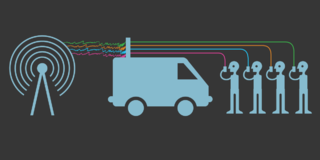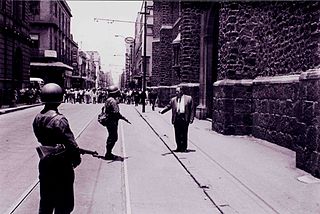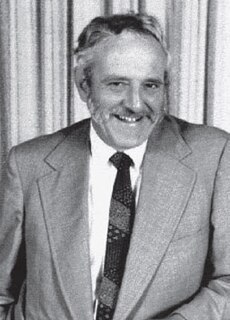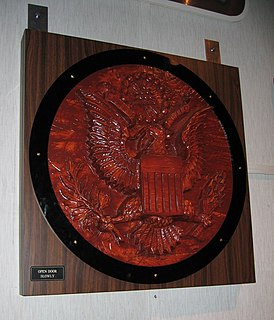 W
WAerial reconnaissance is reconnaissance for a military or strategic purpose that is conducted using reconnaissance aircraft. The role of reconnaissance can fulfil a variety of requirements including artillery spotting, the collection of imagery intelligence, and the observation of enemy maneuvers.
 W
WA transformational growth in air reconnaissance occurred in the years 1939–45, especially in Britain and then in the United States. It was an expansion determined mostly by trial and error, represented mostly by new tactics, new procedures, and new technology, though rarely by specialized aircraft types. The mission type branched out into many sub-types, including new electronic forms of reconnaissance. In sharp contrast with the case during the pre-war years, by 1945 air reconnaissance was widely recognized as a vital, indispensable component of air power.
 W
WThe Big Brother Awards (BBAs) recognize "the government and private sector organizations ... which have done the most to threaten personal privacy". They are named after the George Orwell character Big Brother from the novel Nineteen Eighty-Four. They are awarded yearly to authorities, companies, organizations, and persons that have been acting particularly and consistently to threaten or violate people's privacy, or disclosed people's personal data to third parties.
 W
WBoundless Informant is a big data analysis and data visualization tool used by the United States National Security Agency (NSA). It gives NSA managers summaries of the NSA's worldwide data collection activities by counting metadata. The existence of this tool was disclosed by documents leaked by Edward Snowden, who worked at the NSA for the defense contractor Booz Allen Hamilton. Those disclosed documents were in a direct contradiction to the NSA's assurance to United States Congress that it does not collect any type of data on millions of Americans.
 W
WThe British Commanders'-in-Chief Mission to the Soviet Forces in Germany (BRIXMIS) was a military liaison mission which operated behind the Iron Curtain in East Germany during the Cold War.
 W
WCellphone surveillance may involve tracking, bugging, monitoring, eavesdropping, and recording conversations and text messages on mobile phones. It also encompasses the monitoring of people's movements, which can be tracked using mobile phone signals when phones are turned on.
 W
WThe Central Monitoring System, abbreviated to CMS, is a centralized telephone interception provisioning system installed by the Centre for Development of Telematics (C-DOT), an Indian Government owned telecommunications technology development centre, and operated by Telecom Enforcement Resource and Monitoring (TERM) Cells. The CMC system is going to be set up in each major state collocated with the TERM Cells. Telecom operators in India are required by law to give access to their networks to law enforcement agencies.
 W
WThe Mexican Dirty War refers to the Mexican theater of the Cold War, an internal conflict in the 1960s and 1970s between the Mexican PRI-ruled government under the presidencies of Gustavo Díaz Ordaz, Luis Echeverría and José López Portillo, which were backed by the US government, and left-wing student and guerrilla groups. During the war, government forces carried out disappearances, estimated at 1,200, systematic torture, and "probable extrajudicial executions".
 W
WDropmire is a surveillance program by the United States' National Security Agency (NSA) aimed at surveillance of foreign embassies and diplomatic staff, including those of NATO allies. The program's existence was revealed in June 2013 by whistleblower Edward Snowden in The Guardian newspaper. The report reveals that at least 38 foreign embassies were under surveillance, some of them as far back as 2007.
 W
WXKeyscore is a secret computer system used by the United States National Security Agency (NSA) for searching and analyzing global Internet data, which it collects continually. The NSA has shared XKeyscore with other intelligence agencies, including the Australian Signals Directorate, Canada's Communications Security Establishment, New Zealand's Government Communications Security Bureau, Britain's Government Communications Headquarters, Japan's Defense Intelligence Headquarters, and Germany's Bundesnachrichtendienst.
 W
WFairview is a secret program under which the National Security Agency cooperates with the American telecommunications company AT&T in order to collect phone, internet and e-mail data mainly of foreign countries' citizens at major cable landing stations and switching stations inside the United States. The FAIRVIEW program started in 1985, one year after the Bell breakup.
 W
WThe Five Eyes (FVEY) is an intelligence alliance comprising Australia, Canada, New Zealand, the United Kingdom and the United States. These countries are parties to the multilateral UKUSA Agreement, a treaty for joint cooperation in signals intelligence.
 W
WGlobal mass surveillance can be defined as the mass surveillance of entire populations across national borders.
 W
WJohn J. Hicks was second director of National Photographic Interpretation Center (NPIC). Hicks was appointed as the Director of NPIC in July 1973, after retirement of Arthur C. Lundahl, first director of NPIC. He served as the Director of NPIC from July 1973 to May 1978.
 W
WRobert M. Huffstutler was director of National Photographic Interpretation Center from February 1984 to January 1988.
 W
WInvisible ink, also known as security ink or sympathetic ink, is a substance used for writing, which is invisible either on application or soon thereafter, and can later be made visible by some means. Invisible ink is one form of steganography.
 W
WSir Patrick Michael Leigh Fermor, DSO, OBE, also known as Paddy Fermor, was a British author, scholar, soldier and polyglot who played a prominent role behind the lines in the Cretan resistance during the Second World War. He was widely regarded as Britain's greatest living travel writer during his lifetime, based on books such as A Time of Gifts (1977). A BBC journalist once described him as "a cross between Indiana Jones, James Bond and Graham Greene".
 W
WThe "Five Eyes" (FVEY) refers to an alliance comprising Australia, Canada, New Zealand, the United Kingdom and the United States. These countries are bound by the multilateral UKUSA Agreement for joint cooperation in signals intelligence, military intelligence, and human intelligence. In recent years, documents of the FVEY have shown that they are intentionally spying on one another's citizens and sharing the collected information with each other in order to circumvent restrictive domestic regulations on spying.
 W
WMain Core is an alleged American government database containing information on those believed to be threats to national security.
 W
WThe military liaison missions arose from reciprocal agreements formed between the Western allied nations and the USSR shortly after the end of the Second World War. The missions were active from 1946 until 1990.
 W
WThe Official Secrets Act 1923 is India's anti-espionage act held over from the British colonial period. It states clearly that actions which involve helping an enemy state against India are strongly condemned. It also states that one cannot approach, inspect, or even pass over a prohibited government site or area like an electrical substation. According to this Act, helping the enemy state can be in the form of communicating a sketch, plan, model of an official secret, or of official codes or passwords, to the enemy.
 W
WOnyx is a Swiss intelligence gathering system maintained by the Federal Intelligence Service - Nachrichtendienst des Bundes (NDB). The costs of the system are not public, but the amount of 100 million Swiss francs has been mentioned several times, in particular in 2000 by Werner Marti, SP deputy to the National Council (Switzerland). In March 2005, journalist Urs Paul Engeler estimated that the costs reached 400 million CHF. The Onyx system was launched in 2000, originally under the name SATOS-3, and was completed in late 2005.
 W
WOperations security (OPSEC) is a process that identifies critical information to determine if friendly actions can be observed by enemy intelligence, determines if information obtained by adversaries could be interpreted to be useful to them, and then executes selected measures that eliminate or reduce adversary exploitation of friendly critical information.
 W
WThe Papua conflict is an ongoing conflict in Western New Guinea between Indonesia and the Free Papua Movement. Subsequent to the withdrawal of the Dutch administration from the Netherlands New Guinea in 1962 and implementation of Indonesian administration in 1963, the Free Papua Movement has conducted a low-intensity guerrilla war against Indonesia through the targeting of its military, police, and civilians.
 W
WThe Pearl Harbor advance-knowledge conspiracy theory is the argument that U.S. Government officials had advance knowledge of Japan's December 7, 1941, attack on Pearl Harbor. Ever since the Japanese attack, there has been debate as to how and why the United States had been caught off guard, and how much and when American officials knew of Japanese plans for an attack. In September 1944, John T. Flynn, a co-founder of the non-interventionist America First Committee, launched a Pearl Harbor counter-narrative when he published a forty-six page booklet entitled The Truth about Pearl Harbor.
 W
WPRISM is a code name for a program under which the United States National Security Agency (NSA) collects internet communications from various U.S. internet companies. The program is also known by the SIGAD US-984XN. PRISM collects stored internet communications based on demands made to internet companies such as Google LLC under Section 702 of the FISA Amendments Act of 2008 to turn over any data that match court-approved search terms. Among other things, the NSA can use these PRISM requests to target communications that were encrypted when they traveled across the internet backbone, to focus on stored data that telecommunication filtering systems discarded earlier, and to get data that is easier to handle.
 W
WAccording to a 2007 newspaper report, Source Columba was the code name for the Confidential Pigeon Service, an unconventional British intelligence gathering operation in World War II.
 W
WStandard Form 86 is a U.S. government questionnaire that individuals complete in order for the government to collect information for "conducting background investigations, reinvestigations, and continuous evaluations of persons under consideration for, or retention of, national security positions." SF 86 is distinguished from SF 85, which is used for public trust or lower-risk positions. The form is required to be completed by military personnel, government contractors, and government employees in order to receive a requisite security clearance. Information demanded in the form include any colleges or universities attended over the past three years, an account of the last ten years of the individual's employment, ties to foreign nationals and governments, overseas travel, a list of past residences, etc.
 W
WTeufelsberg is a non-natural hill in Berlin, Germany, in the Grunewald locality of former West Berlin. It rises about 80 metres (260 ft) above the surrounding Teltow plateau and 120.1 metres (394 ft) above the sea level, in the north of Berlin's Grunewald Forest. It was named after the Teufelssee in its southerly vicinity. The hill is made of debris and rubble, and covers an unfinished Nazi military-technical college. During the Cold War, there was a U.S. listening station on the hill, Field Station Berlin. The site of the former field station is now fenced off and is currently being managed by an organisation which charges 5 to 10 euros for public access.
 W
WThe Thing, also known as the Great Seal bug, was one of the first covert listening devices to use passive techniques to transmit an audio signal. It was concealed inside a gift given by the Soviet Union to W. Averell Harriman, the United States Ambassador to the Soviet Union, on August 4, 1945. Because it was passive, needing electromagnetic energy from an outside source to become energized and active, it is considered a predecessor of radio-frequency identification (RFID) technology.
 W
WThe Third Tunnel of Aggression is one of four known tunnels under the border between North Korea and South Korea, extending south of Panmunjom.
 W
WThe United Kingdom – United States of America Agreement is a multilateral agreement for cooperation in signals intelligence between Australia, Canada, New Zealand, the United Kingdom, and the United States. The alliance of intelligence operations is also known as the Five Eyes. In classification markings this is abbreviated as FVEY, with the individual countries being abbreviated as AUS, CAN, NZL, GBR, and USA, respectively.
 W
WUpstream collection is a term used by the National Security Agency (NSA) of the United States for intercepting telephone and Internet traffic from the Internet backbone, i.e. major Internet cables and switches, both domestic and foreign. Besides the Upstream collection, NSA also gathers information from Internet communications through arrangements with Internet companies under the program codenamed PRISM. Both the Upstream programs and PRISM are part of the Special Source Operations (SSO) division, which is responsible for collection in cooperation with corporate partners.
 W
WJohn Vassos whose career as an American industrial designer and artist helped define the shape of radio, television, broadcasting equipment, and computers for the Radio Corporation of America for almost four decades. He is best known for both his art deco illustrated books and iconic turnstile for the Perey company, as well as modern radios, broadcast equipment, and televisions for RCA. He was a founder of the Industrial Designers Society of America, in 1965, serving as its first chairman simultaneously with Henry Dreyfuss as its president. Vassos' design philosophy was to make products that were functional for the user.
 W
WWikiLeaks is an international non-profit organisation that publishes news leaks and classified media provided by anonymous sources. Its website, initiated in 2006 in Iceland by the organisation Sunshine Press, stated in 2015 that it had released online 10 million documents in its first 10 years. Julian Assange, an Australian Internet activist, is generally described as its founder and director. Since September 2018, Kristinn Hrafnsson has served as its editor-in-chief.